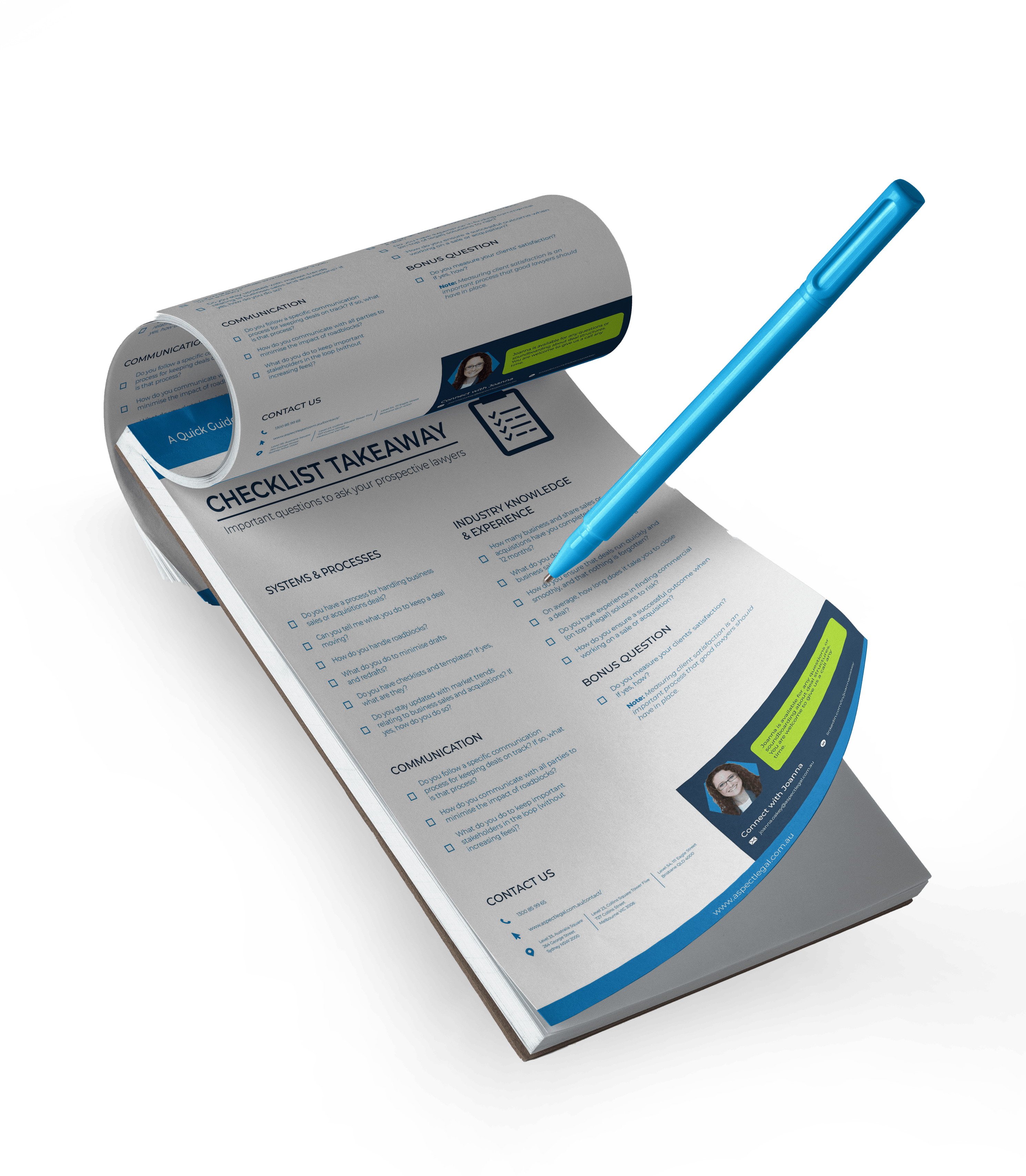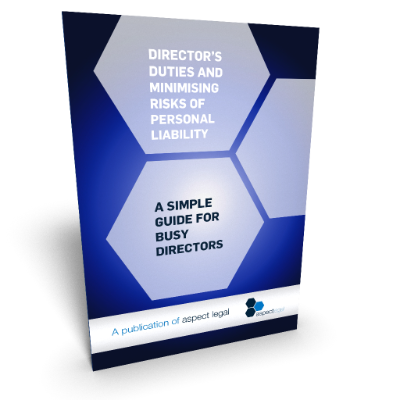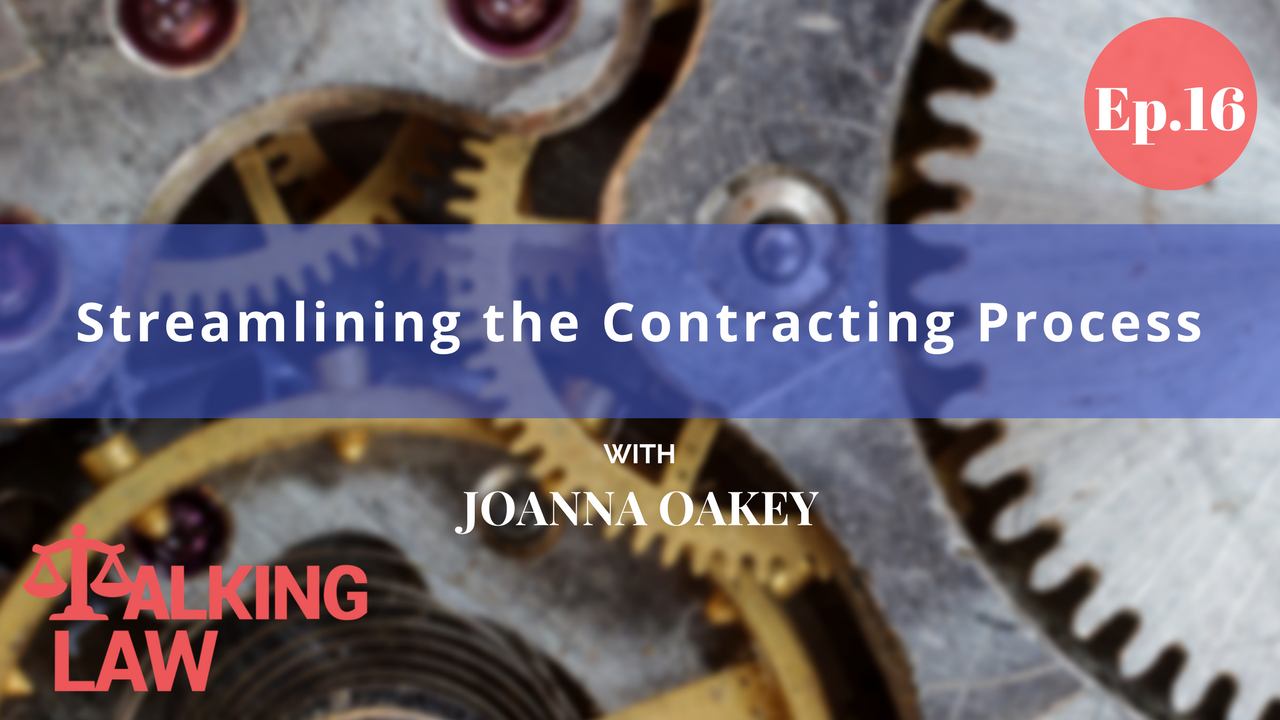
In the last episode, I talked about issues caused by a lack of sufficient detail in contracts or even worse, a failure to have a finalised contract before performance starts (which happens more often than you might think). The problem is that without a contract or without clear terms in the contract, there is risk of ambiguity. Where there is ambiguity, there is risk of argument. Where there is argument, there is often wasted amounts of time, money and other resources.
Episode Highlights:
00:37 Relevance of streamlining
01:59 Three main issues
05:07 Ways to streamline the contracting process
05:43 Chunking time
06:25 Starting a list
07:10 Creating templates
07:50 Setting up a process
09:28 Using checklists
10:07 Version control your templates
12:35 Common objections
15:12 Action steps
The aim here is for us to set up systems in place to ensure that we don’t get to the position where we are wasting time and money dealing with arguments that could have been prevented by having the right systems in place, or contracts in place, or terms in place from the beginning.
But first we need to have a look at the cause of the issue. Why are contracts finalised before performance under them starts? Why are they lacking in appropriate detail such that they cause ambiguity and argument?
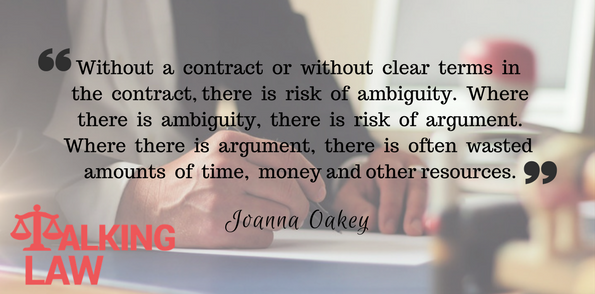
3 Main Issues
I often speak about these issues, either with clients or with people who attend seminars that I speak at. No matter what the size of the organisation, whether it’s an SME or one of Australia’s leading organisations or multinationals, it all often comes back to three main issues.
1. Lack of time
No matter what the size of an organisation, everyone within every organisation that I deal with is always busy and often contracts are just one of those things that are less enjoyable and seen as less important than many of the other tasks that people perform on a daily basis.
2. Lack of risk consideration
This sort of ties into the issue of lack of time. Not only is everyone so busy, often they’re too busy to sit down and think about what the real risks are in each of the transactions that they’re dealing with on a contractual basis.
3. Lack of understanding
A lack of understanding about how to cover those things in a contract or even what should be covered in a contract; Or how to cover a breach or if something that you have agreed on doesn’t occur the way you want it to occur. What I mean by this is often people don’t understand that if they want a right of termination for something not happening in the contract, they need to specifically build in this right for themselves; Or if they want a right of redress in relation to service or quality or other elements of a contract not being met, they need to be really clear about what the expectation is for what performance looks like under those elements. This runs both ways, whether you’re dealing with a supplier to your organisation or your customers.
In each of these situations it’s extremely important that people dealing with contracts understand the elements of the contract that are relevant to the contracting situation and know what to include in those contracts to ensure the best chance of parties achieving what each of them are meant to achieve under the contract.
Unfortunately, managing risk is often an afterthought that only raises its head only when a problem occurs. People also forget about the other aspect of having contracts in place which is obviously about the management of risks but also about underpinning what success looks like between the parties and setting up the right atmosphere to encourage success because it’s been clear to both parties what success looks like.
Getting around these problem areas
How long can an organisation get around these three issues? The answer is in creating a process to streamline the way your business or your department deals with contracts. How can you do this?
Chunking Time
One way to start in this area is to set aside some time specifically for this area. I’m reading a great book at the moment about deep work, which I might talk about in another episode of this podcast. Essentially, the concept is that for important tasks, (and certainly overlooking the contract process within your organisation or department is a deeply important task) needs to be given an allocated time away from distractions.
You need to allocate whoever it is in your organisation who’s going to be looking at this issue. Give them a mandate to spend a particular period of time looking at the process of contracts within your organisation.
Start a list
Once someone has the time, the task are:
Firstly, reflect back over the last year (at least the last year or maybe even further than that) and think about the main contracts in your area of the business or the business as a whole. If you’re looking at this process on behalf of your business as a whole, reflect back on what the main contracts have been both with suppliers and with clients (or depending on your organisation, it may just be one or the other) or any other third parties.
Next, list down types of relationships and any sorts of issues that have occurred along the way with any of these relationships in the past. Of course, warding off areas where you’ve had issues in the past is a great start to ensuring that you don’t have those again in the future.
Create templates
For each of these main areas, you should consider putting together a suite of templates for your organisation. On the other hand, if you usually have to sign another party’s contract, (say for example, you deal with counter parties who are often larger than your organisation or if you deal with specialised types of contracts, it makes more sense for you to be executing the contracts or dealing with the contracts that come in from your counter-party) you should at least be creating checklists of your preferred positions in relation to dealing with the risks that relate to the areas and obligations.
Set up a process
The next area you should be thinking about is creating a process for whoever is in your organisation reviewing the contracts that come in. Ideally, you should be choosing one person in your department or your organisation to be the main conduit of contracts.
Even if you’re generally using outsourced legal, (which is a great idea in these situations particularly if you’re dealing with contracts that have a real element of potential risk or potential for argument in the future involved) it is best to have one person in the organisation or a number of people in the organisation who are familiar with your process of dealing with these contracts.
Choose a person or number of people within the organisation to deal with the contracts. Then get them trained up and familiar with the terms of what each common types of clauses within these agreements that you regularly deal with actually mean. You can get them trained up by sending them on formal courses to understand contract terms a bit more. You could also get them trained up by getting them to listen to all of our podcast episodes here at Talking Law for understanding the types of terms and issues that deal with contracts. You can likewise have this by developing a close relationship with your lawyers so that as you work together with them through each contract, you get a feel for where the areas of significance appear in each of these contracts.
Have a checklist
Once you’ve done that, you should be creating a checklist for the major things to look out for. For example, as I said this might be areas in the past that have created issue. You might also want to get some advice from other people in the industry or legal advisers. You can also brainstorm with other people in your team or your organisation about what the risks are in the types of situations that you’ve identified as the main contracting relationships.
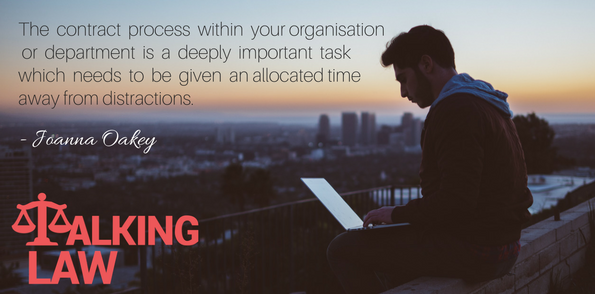
Version control your templates
Then the last thing to do is to ensure that these templates and checklists are stored in a way that’s easy to access in the future, together with a process that you’ve created internally to know if there are changes made to the document.
A few small changes over time, made by different people within the organisation can do a lot of harm to a template. I’ve seen lots of templates come back to us so different from the templates we had initially created that often they completely lose their legal effect.
It’s really important to ensure that you have version control over the templates that are saved within your organisation system and that you have a way to deal with any changes made to those templates so that these changes are not impacting the legal effect of the templates themselves.
The last area to think about is how the individual working through the template or checklist is going to understand whether or not the risks have been covered off within the contract. I’d certainly recommend that whoever’s dealing with your contracts within your organisation have enough understanding about how to tie in other elements of a contract (e.g. the statement of works or the service level agreements that go with them or things set out in the schedule) and how to tie those sorts of things back in to the contract if performance of any of those areas is critical or has any importance to the contract as a whole.
Common objections
Some of the objections that I often see or hear in relation to going through this process of getting a clearly defined way of dealing with contracts within an organisation are useful for me to deal with today.
“We have good relationships so we don’t really need one.”
One of those objections I get is people saying to me that they’ve got a close relationship with all of their suppliers or all of their customers so they don’t think problems are likely to occur or things are likely to get nasty. But it’s important to understand that things can change. Management can change. Businesses can be sold. Personnel within businesses can change.
More than that, contracts are a way of helping you cover off the detail that you might not always think to create. Contracts help to set up a relationship. They help to set up a relationship that provides you with that stability if things change. They also sit there to help in situations where even if people don’t change memories can dim. Sometimes the issue might be that conversations have not been had about some of these important points. The contract is sitting there to set up a relationship between each of the parties to withstand changes in personnel, changes in business culture, or the diming of memory with time.
“We’re just too busy.”
Another argument that I often hear is that people don’t have time. They don’t have time to go back and set up a proper process for dealing with their contracts or a proper suite of templates and a proper checklist of things to be considering.
My argument is that disagreements take up a lot more time than you often realize – a lot more time, a lot more money, a lot more resources. So it really makes sense to ward these issues off the past and to set time out right at the beginning for you to go through each of these areas that are important to set up so that you can get a suite of templates set up, your checklist set up and your process set up right from the beginning to help you get into the situation where you avoid arguments that are time sapping and resource sapping.
“We don’t have anyone who can do it.”
And then the final objection that I hear over time is that organisations don’t have someone who is available who understands in an appropriate way the things that they’re dealing with in a contract and that’s totally understandable. In that instance, you should be outsourcing it. We work in this way with lots of our clients.
Action Steps
That brings us to the four main action steps coming out of today’s podcast.
- 1) Appoint someone in your organisation or department with primary responsibility for the contracts or dealing with an outsourced legal in relation to each of these contracts. Make sure they are trained up either using formal training or by having that close relationship with your legal advisers to help them understand what the important elements in each contract and negotiation are from a contractual perspective.
- 2) Brainstorm the risks in each usual contracting relationship so you’ve got a clear understanding at the outset and so you don’t have to do this each time from scratch.
- 3) Create a checklist for the major things to look out for in each of these types of contracts.
- 4) Create templates that are often used for these types of contracts so that you can have a template from your suite of templates for you to draw from and even if you’re not able to use your contract with your contracting customer or supplier at least you’ll have your contract to compare back to or to send through to your lawyers as a check in relation to the types of risk positions that you usually adopt in relation to each of these relationships.

Quick recap
Just a quick recap. In this episode we talked about:
- Ways to streamline the contracting process
- Relevance of streamlining the contract process
- Importance of understanding the major elements in a contract
- Importance for the person who is going to be dealing with your contracts to have some understanding (or at least have someone that they can rely on to give them understanding) of the major elements of each of these contracts
- Action steps about appointing someone in your organisation to deal with the contracts, brainstorming the risks in each of the usual contracting relationships, and using checklists and templates.
If you’d like more information about this topic head over to our website at talkinglaw.com.au where you’ll be able to download a transcript of this podcast episode if you want to read it in more detail.
You’ll also find details there of how to contact our lawyers at Aspect Legal if you’d like help with any of the items we covered today. And finally, if you enjoyed what you heard today, please pop over to iTunes and leave us review. Thanks again for listening in and see you next time!







